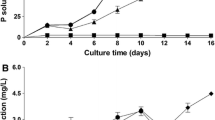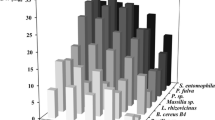Abstract
The behavior of ectomycorrhizal (ECM) fungi on exposure to cadmium dependent upon isolation remains a poorly understood phenomenon. The in vitro growth, tolerance, and accumulation of Cd were studied in three strains of ECM fungi exposed to six Cd concentrations (0–10 mg L−1). The fungi studied were a strain of Scleroderma citrinum Persoon (Sc) isolated from a tailings heap containing 5 mg kg−1 available Cd, and two strains of Pisolithus tinctorius (Pers.) Coker and Couch from unpolluted sites (Pt1 and Pt2), both common ECM fungi used for remediation. The growth kinetic (36 days) of Sc was not affected by Cd concentration. By contrast, the ED50 in Pt1 and Pt2 occurred at 4.8 and 6.9 mg L−1 of Cd, respectively. The biomass of the three fungi exposed to the highest Cd concentration (10 mg L−1) was significantly different. Sc presented the highest biomass, while this was strongly reduced for Pt1 and Pt2. The tolerance index for Sc ranged from 78% to 95% at all Cd concentrations tested, while for Pt1 it was 49% and 31%, and for Pt2 it was 62% and 35% at 5 and 10 mg of Cd L−1, respectively. The mycelium of both Pt strains accumulated more Cd than the Sc mycelium. At the highest Cd concentration, Pt1 and Pt2 accumulated 1.9 and 1.7 times more Cd than Sc. This study suggests that regardless of the differences in tolerance to Cd by the three ECM fungi, they could have biotechnological applications for soil remediation. However, Sc has greater possibilities of being used successfully when high concentrations of Cd prevail in the environment.



Similar content being viewed by others
References
Dahlberg A (2001) Community ecology of ectomycorrhizal fungi: an advancing interdisciplinary field. New Phytol 150:555–562
Krznaric E, Verbruggen N, Wevers JHL, Carleer R, Vangronsveld J, Colpaert JV (2009) Cd-tolerant Suillus luteus: a fungal insurance for pines exposed to Cd. Environ Pollut 157:1581–1588
Blaudez D, Botton B, Chalot M (2000) Cadmium uptake and subcellular compartmentation in ectomycorrhizal fungus Paxillus involutus. Microbiology 146:1109–1117
Hall JL (2002) Cellular mechanisms for heavy metal detoxification and tolerance. J Exp Bot 53:1–11
Ledin M, Krantz-Rulcker C, Allard B (1999) Microorganisms as metal sorbents: comparison with other soil constituents in multi-compartment systems. Soil Biol Biochem 31:1639–1648
Berthelsen BO, Olsen RA, Steinnes E (1995) Ectomycorrhizal heavy metal accumulation as a contributing factor to heavy metal levels in organic surface soils. Sci Total Environ 170:141–149
Jentschke G, Godbold DL (2000) Metal toxicity and ectomycorrhizal. Physiol Plantarum 109:107–1168
Kabatia-Pendias A (2001) Trace elements in soils and plants, 3rd edn. CRC, Boca Raton
Carrillo Gonzalez R, González-Chávez MCA (2006) Metal accumulation in wild plants surrounding mining wastes. Environ Pollut 144:84–91
Gonzalez-Chávez MC, Carrillo-González R, Gutiérrez Castorena MC (2009) Natural attenuation in a slag heap contaminated with cadmium: the role of plants and arbuscular mycorrhizal fungi. J Hazard Mat 161:1288–1298
Gussarsson M, Jensén P (1992) Effects of copper and cadmium on uptake and leakage of K(+) in birch (Betula pendula) roots. Tree Physiol 11:305–313
Cripps CL (2002) Native mycorrhizal fungi with aspen on smelter-impacted sites in the Northern Rocky Mountains: occurrence and potential use in reclamation. In: National Meeting of the American Society of Mining and Reclamation and the 9th Billings Land Reclamation Symposium, Billings, MT. ASMR, Lexington
Benson LM, Evans RL, Peterson PJ (1980) Occurrence of basidiomycetes on arsenic–toxic mine waste. Trans Br Mycol Soc 74:199–201
Howe R, Evans RL, Ketteridge SW (1997) Copper-binding proteins in ectomycorrhizal fungi. New Phytol 135:123–131
Baldrian P, Gabriel J (2002) Intraspecific variability in growth response to cadmium of the wood-rooting fungus Piptoporus betulinus. Mycologia 94:428–436
Colpaert JV, van Assche JA (1992) The effects of cadmium and the cadmium–zinc interaction on the axenic growth of ectomycorrhizal fungi. Plant Soil 145:237–243
Kumar S, Satyanarayana T (2002) Isolation of ectomycorrhizal fungi: methods and techniques. In: Mukerji KG, Manoharachary C, Chamola BP (eds) Techniques in mycorrhizal studies. Kluwer Academic, Netherlands, pp 133–142
HeinonenTanski H, Holopainen T (1991) Maintenance of ectomycorrhizal fungi. In: Norris JR (ed) Techniques for the study of mycorrhiza, vol 23. Academic Press, London, pp 413–422
Sánchez F, Honrubia M, Torres P (2001) Effect of pH, water stress and temperature on in vitro cultures of ectomycorrhizal fungi from Mediterranean forests. Cryptogamie Mycol 22:243–258
Molina R, Palmer JG (1982) Isolation, maintenance and pure culture manipulation of mycorrhizal fungi. In: Schenck NC (ed) Methods and principles of mycorrhizal research. The American Phytopathological Society, St Paul, pp 115–129
Colpaert JVP, Vandenkoornhuyse P, Adriaensen K, Vangronsveld J (2000) Genetic variations and heavy metal tolerance in the ectomycorrhizal basidiomycete Suillus luteus. New Phytol 147:367–379
Wels B, Sperling M (2007) Atomic absorption spectrometry, 3rd edn. Wiley-VCH, New York
SAS Institute (1999) SAS user’s guide, ver. 8. SAS Institute Inc, Cary, 595 p
Colpaert JV, Van Assche JA (1987) Heavy metal tolerance in some ectomycorrhizal fungi. Funct Ecol 1:415–421
Zheng W, Fei Y, Huang Y (2009) Soluble protein and acid phosphatase exuded by ectomycorrhizal fungi and seedlings in response to excessive Cu and Cd. J Environ Sci 21:1667–1672
Golubović Ćurguz V, Tabaković-Tošić M, Veselinović M, Raičević V, Dražić D, Jovanović LJ, Kiković D (2010) The influence of heavy metals on the growth of ectomycorrhizal fungi. Minerva Biotecnol 22:17–22
Fomina MA, Alexander IJ, Colpaert JV, Gadd GM (2005) Solubilization of toxic metal minerals and metal tolerance of mycorrhizal fungi. Soil Biol Biochem 37:851–866
Denny HJ, Wilkins DA (1987) The mechanism of ectomycorrhizal amelioration of zinc toxicity. New Phytol 106:545–553
Ray P, Adholeya A (2009) Correlation between organic acid exudation and metal uptake by ectomycorrhizal fungi grown on pond ash in vitro. BioMetals 22:275–281
Fomina M, Charnock JM, Hillier S, Alexander LJ, Gadd GM (2006) Zinc phosphate transformations by the Paxillus involutus/pine ectomycorrhizal association. Microb Ecol 52:322–333
Fomina MA, Alexander IJ, Hillier S, Gadd GM (2004) Zinc phosphate and pyromorphite solubilization by soil plant-symbiotic fungi. Geomicrobiol J 21:351–366
Bellion M, Courbot M, Jacob C, Blaudez D, Chalot M (2006) Extracellular and cellular mechanisms sustaining metal tolerance in ectomycorrhizal fungi. FEMS Microbiol Lett 254:173–181
Bellion M, Courbot M, Jacob C, Guinet F, Blaudez D, Chalot M (2007) Metal induction of a Paxillus involutus metallothionein and its heterologous expression in Hebeloma cylindrosporum. New Phytol 174:51–158
Mullen MD, Wolf DC, Ferris FG, Beveridge TJ, Flemming CA, Bailey GW (1989) Bacterial sorption of heavy metals. Appl Environ Microbiol 55:3143–3149
Gadd GM (1993) Interactions of fungi with toxic metals. New Phytol 124:25–60
Acknowledgments
This study was a part of the project research CONACYT-SEMARNAT 2002-COI-739: Bioremediation of heavy metal polluted soils using plants and their symbiotic microorganisms. Critical comments from Dr. Alan Baker are greatly appreciated.
Author information
Authors and Affiliations
Corresponding author
Rights and permissions
About this article
Cite this article
Carrillo-González, R., González-Chávez, M.d.C.A. Tolerance to and Accumulation of Cadmium by the Mycelium of the Fungi Scleroderma citrinum and Pisolithus tinctorius . Biol Trace Elem Res 146, 388–395 (2012). https://doi.org/10.1007/s12011-011-9267-7
Received:
Accepted:
Published:
Issue Date:
DOI: https://doi.org/10.1007/s12011-011-9267-7




